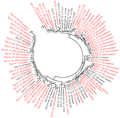 作者
作者  通讯作者
通讯作者
基因组学与生物技术, 2013 年, 第 2 卷, 第 2 篇 doi: 10.5376/gb.cn.2013.02.0002
收稿日期: 2013年03月25日 接受日期: 2013年03月30日 发表日期: 2013年04月10日
Young, 2013, Molecular Profile of Treeshrew, a Promising Experimental Animal for Medical Research, Int'l J. Mol. Zoo., Vol.3, No.5, 17-19 (doi:10.5376/ ijmz.2013. 03.0005)
在灵长类总目中的树鼩目有2个科5个属,共20个种,其中树鼩属(Tupaia)有15个种,为最大的一个属。树鼩目中的大多数种的染色体组型为2n=52~68,其中著名的普通树鼩(Tupaiaglis)的2n=60;西部树鼩(Tupaiabelangerichinensis)的2n=62;倭树鼩(Tupaia minor)和山树鼩(Tupaiamontana)的染色体数分别为2n=66的2n=68;但菲律宾树鼩(Urogaleeveretti)的染色体组型为2n=44。北方树鼩(Tupaiabelangerichinensis)的全基因组已经测序,基因组大小为2.86 GB,大约含有22 063蛋白编码基因,鉴定出28个树鼩与灵长类共有的功能性基因,之前的研究认为这些基因是灵长类所特有;树鼩基因组中含有35%的重复元件以及14%的重要的转座子。一些重要基因家族的功能注释,将有助于树鼩更好的成为一种用于药物评价的替代非人灵长类的试验动物。
树鼩是灵长类总目中树鼩目的一种较为原始的小型哺乳动物,生长在东南亚、南亚热带地区。树鼩目中有2科:树鼩科和笔尾树鼩科;5个属:南印树鼩属、细尾树鼩属、树鼩属、菲律宾树鼩属及笔尾树鼩属,共20个种,其中树鼩属(Tupaia)有15个种,为最大的一个属(Young, 2011)。随着北方树鼩的全基因组测序的完成,树鼩的系统分类地位得到了分子遗传学水平上的证实(Fan et al., 2013; Young, 2013)。
1树鼩染色体信息
树鼩目中的大多数种的染色体组型为2n=52~68,只有菲律宾树鼩(Urogaleeveretti)的染色体组型为2n=44 (Chu and Bender, 1962)。已有的研究表明:巴拉望树鼩(Tupaiapalawanensis)的2n=52 (Arrighi et al., 1969; Bender and Chu, 1964);普通树鼩(Tupaiaglis)和长脚树鼩(Tupaialongipes)的2n=60 (Arrighi et al., 1969; Hsu and Johnson, 1963; Bender and Chu, 1964);北方树鼩之中国亚种(Tupaiabelangerichinensis),越北亚种(Tupaiabelangeritonquinia)和瑶山亚种(Tupaiabelangeriyaoshanensis)的染色体数目均为2n=62 (刘瑞清等, 1989);倭树鼩(Tupaia minor)的2n=66 (Arrighi et al., 1969);山树鼩(Tupaiamontana)的2n=68 (Arrighi et al., 1969; Lisco et al., 1973)。
2中国树鼩基因组概况
最新的树鼩全基因组测序数据于2013年2月5日在线发表在国际著名学术期刊《Nature Communications》上,论文题目为《Genome of the Chinese Tree Shrew》。Yao和他的研究组利用一只来自中国云南昆明的雄性北方树鼩(Tupaiabelangerichinensis)测序了其全基因组,总覆盖度高达79x,获得了一个基因组大小为2.86 GB的参考基因组(表1),接近由K-mer计算估算的3.2 GB的基因组大小。树鼩基因组大约含有22,063蛋白编码基因,接近人类基因数量;在基因组中含有35%的重复元件以及14%的重要的转座子。
.png) 表1 中国树鼩基因组的总体统计(摘自:Fan et al., 2013) Table 1 Global statistics of the Chinese tree shrew genome (Adopted from Fan et al., 2013) |
3树鼩重要功能基因
树鼩基因组大约含有22 063蛋白编码基因。树鼩基因组中的一些基因家族发生了扩张(图1),例如免疫球蛋白λ轻链(IGLV)基因家族等;出现了一些假基因和基因丢失现象,比如前列腺特异性转谷氨酰酶4基因(TGM4);树鼩基因组中缺失DDX58基因,该基因功能的缺失,表明免疫反应的中断可能在造成丙肝感染中具有重要作用;一些重要功能基因出现了提前终止或者移码突变以致基因功能丧失,如细胞防御酸刺激的NOX1基因的假基因化。
 图1 树鼩IGLV基因家族的特异扩张(摘自: Fan et al., 2013) Figure 1 Specific expansion of the immunoglobulin lambda variable (IGLV) gene family in tree shrews (Adopted from Fan et al., 2013) |
TRIM5,一种宿主限制性因子,在树鼩基因组中存在5个串联重复拷贝(图2),其中一个具有CypA逆转录转座插入,形成了TrimCyp嵌合转录体,这种现象仅发生在少数灵长类中,在限制逆转录病毒活性中具有重要意义(Fan et al., 2013)。
.png) 图2 树鼩与人类的TRIM基因簇(摘自: Fan et al., 2013) Figure 2 Trim gene cluster in tree shrew and human (Adopted from Fan et al., 2013) |
树鼩基因组中鉴定出28个树鼩与灵长类共有的功能性基因,之前的研究认为这些基因是灵长类所特有的(Fan et al., 2013);树鼩基因组中包含209个与人类相同的视觉相关基因,但是相比于人类,却缺少了两种中波长视蛋白基因,说明树鼩其与低等灵长类一样,是二元色视觉动物(Fan et al., 2013)。
树鼩基因组中鉴定出23个已知的神经递质转运蛋白(Fan et al., 2013),这些神经递质转运蛋白是抗抑郁药物的重要靶点,可以通过抑制其活性实现对抑郁病患者的治疗。
细胞色素P450超家族能够编码一些与药物代谢、活化和相互作用相关的一些酶。树鼩拥有与人类非常接近的细胞色素P450超家族的组成结构和基因一致性(Fan et al., 2013)。这种在人和树鼩中的药物靶点以及相关信号通路的保守性,使得树鼩更好的用于评价用于药物分布、药物靶点、药代动力学以及药物副作用研究。
参考文献
Arrighi F.E., Sorenson M.W., and Shirley L.R., 1969, Chromosomes of the treeshrews (Tupaiidae), Cytogenet. Genome Res., 8(3): 199-208
http://dx.doi.org/10.1159/000130062
Bender M.A., and Chu E.H.Y., 1964, The chromosomes of Primites, In: Janusch J.B. (ed.), Evolutionary and genetic biology of primites, Vol. 1, Academic Press, New York, pp.261-310
Chu E.H.Y, and Bender M.A., 1962, Cytogenetics and evolution of primates, Ann. N. Y. Acad Sci., 102: 253-266
http://dx.doi.org/10.1111/j.1749-6632.1962.tb13644.x
PMid:14021190
Fan Y., Huang Z.Y., Cao C.C., Chen C.S., Chen Y.X., Fan D.D., He J.,Hou H.L., Hu L., Hu X.T., Jiang X.T., Lai R., Lang Y.S., Liang B., Sheng-Guang Liao S.G., Mu D., Ma Y.Y., Niu Y.Y., Sun X.Q., Xia J.Q., Xiao J., Xiong Z.Q., Xu L., Yang L., Zhang Y., Zhao W., Zhao X.D., Zheng Y.T., Zhou J.M., Zhu Y.B., Zhang G.J., Wang J., and Yao Y.G., 2013, Genome of the Chinese tree shrew, Nature Communications, 4: 1426 DOI: 10.1038/ncomms2416
http://dx.doi.org/10.1038/ncomms2416
Hsu T.C., and Johnson M.L., 1963, Karyotype of two mammals from Malaya, The American Naturalis, 97: 127-129
http://dx.doi.org/10.1086/282262
Lisco H., Elliot O.S., Irwin I., and Lisco E., 1973, A note on chromosomes of two species of tree shrews (Tupaiidae), Primates, Vol 14, No.2-3, 305-308
http://dx.doi.org/10.1007/BF01730826
Liu R.Q., Shi L.M., and Chen Y.Z., 1989, Comparative studies on chromosomes of 3 subspecies of Tupaiabelangeri, Zoological Research, Vol 10, No3, 195-202 (刘瑞清, 施立明, 陈玉泽, 1989, 树鼩(TupaiabelangeriWagner)三个亚种的染色体比较研究, 动物学研究, Vol 10, No.3, 195-202)
Young P.A., 2011, Treeshrews, the primitive primate mammals for medical experimental animals, Intl. J. of Molecular Zoology, Vol.1, No.2, 4-6 (doi:10.5376/ijmz.2011.01.0002)
http://dx.doi.org/10.5376/ijmz.2011.01.0002
Young P.A., 2013, Genomic evidence supported teeshrew is closely related to primates, Intl. J. of Mol. Evolution and Biodiversity, Vol.3, No.1, 1-4 (doi:10.5376/ijmeb.2013.03.0001)
http://dx.doi.org/10.5376/ijmeb.2013.03.0001